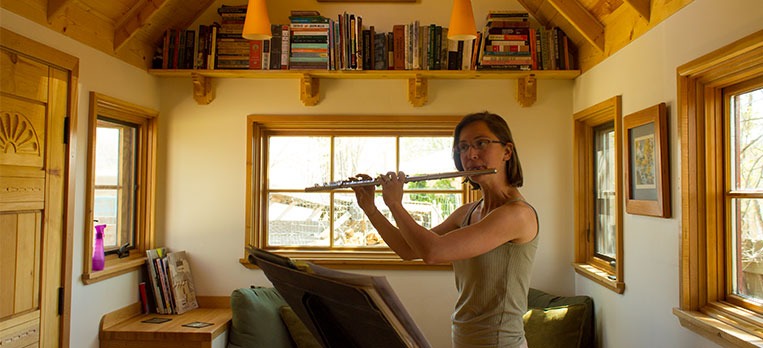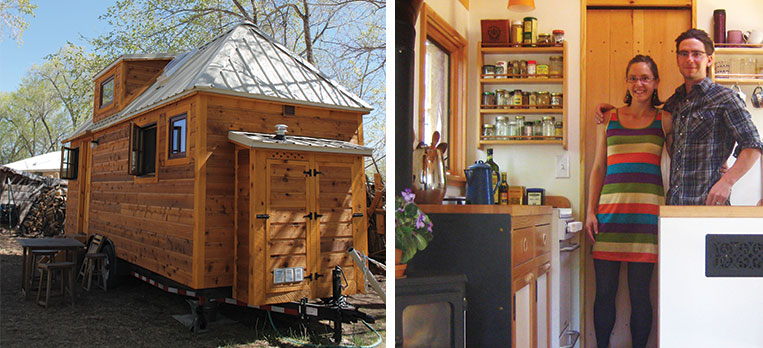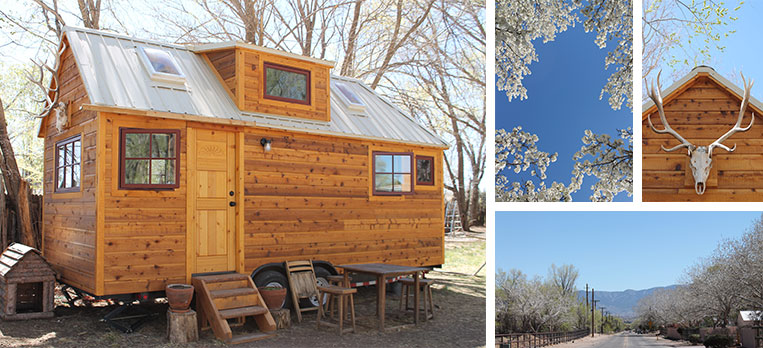This post is by Billy Ulmer, author of the Life in a Tiny House ebook.

What are your priorities? It’s surprisingly hard to be clear about that, after a lifetime of having products and whole lifestyles advertised at us. That’s part of why tiny houses can be so polarizing: they represent a growing shift away from the priorities that mainstream, material culture assumes we all share.
Many people feel instantly drawn to tiny houses, seeing freedom and simplicity. But meanwhile, material culture struggles to understand the appeal, because it assumes we all have the same priorities: financial success, and the freedom to buy anything we want. Material culture scratches its head and asks, “Why choose less when you could choose more?”
But to the people that admire or live in them, tiny houses do offer more. More leisure time, more career flexibility, more opportunity to save money, and more options for where to live. But as with most choices, all that “more” comes at the expense of something else. When you choose a tiny home, it’s the volume of space and material possessions that end up on the chopping block. The question is, does that work for you?
Housing Expectations Versus Housing Needs
That trade-off does work for Esther and Kenny, who I tracked down through their blog about the beautiful tiny house they built in Albuquerque, New Mexico. Impressively, they knew their priorities – to do the work they want (even if it won’t make them rich), to have time to spend with the people they love and the hobbies they enjoy, and to live in a beautiful house.
To Esther and Kenny, the size of the beautiful house was less of a priority. As Esther described her view on what a house needs to offer, “You need a place to sleep, you need a place to cook and prepare food, and you need a place to hang out. And you can fit that in 140 square feet.”
With that perspective, a tiny house on wheels was a great fit for their situation. It allows them to do the jobs that interest them, work flexible schedules, and yes, to live in a beautiful house. It turns out that nice materials are more affordable when you don’t need much of them. While some tiny home builders emphasize thrifty decisions and salvaged everything, Kenny and Esther valued their small purchases of high-quality materials. And they invested plenty of their hobby and interest time back into the house – Kenny made their custom cabinets, welded the hardware for their barn-style bathroom door, and even milled some of their own lumber.
Unfortunately Kenny wasn’t available when I visited, but Esther toured me around and talked with me about their inspirations, building process, and their future plans to try and buy land and “make the house legit.” This is an abridged and edited highlight of my visit to Esther and Kenny’s home, but there’s much more in my ebook, Life in a Tiny House.

Billy: What have you noticed about the people you’ve met who are interested in tiny houses?
Esther: I think people are kind of fed up with working to live. People don’t want to spend all their lives just working to keep up with bills. People are looking for ways to… instead of working and making more money, just downsizing and saving money that way.
That’s how we felt. I’m a musician. Kenny’s a woodworker, does tree climbing, that kind of outdoorsy stuff. But we’re not in big, money-making careers. So instead of thinking, “How can we make more money?” We were thinking, “How can we downsize our needs?” Because we’re never going to make that much money. But, let’s do this in a way where we can live comfortably, and do the stuff we want to do. We have a lifestyle where we want to have flexible schedules. So if we want to go backpacking for a week, we’re not committed to a nine to five, and we can do that.
I think that’s a common thing. People wanting quality of life in terms of time, not in terms of material things.

Billy: If that was your priority, was there anything else you considered before the tiny house?
Esther: We thought about a yurt. Which would be cool, but it feels a little primitive, you know? And one of the cool things about building on a small scale is that you can actually afford to use really nice materials.
If you had a full-sized house, doing butcher block countertops and real wood floors? That’s SO expensive. But on this scale, that’s doable. At each step when we were coming to things like the floor or the siding, we could spend THIS much money on the really cheap, generic stuff, or we could spend THIS much money on the really nice, high-quality, real wood stuff. And when you’re building on a small scale, the difference between those two numbers isn’t that bad. Whereas if you’re building a 2,000 square foot house, it’d be like, “Ugh! Okay, let’s do the cheap, ugly one!”
We wanted to live in a space that was beautiful and had nice materials and looked nice, and building small was one of the only ways we could do it on the budget that we had.
Visit their blog to learn more about Esther and Kenny’s tiny house.

Comments are closed.